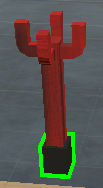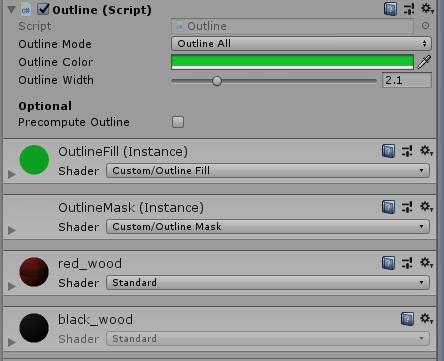- Home /
QuickOutline: how can I change the shader to work with objects with two materials?
Hello folks,
I'm trying to create an outline effect that works also in VR and I am using the QuickOutline asset from the asset store with Unity Version 2018.4.8f1.
The problem is that I have some model that has more than one material and that makes the outline appear only one part of it.
Do you know why and how can I solve it? 
I found out that the same thing happens when using different shader found online on objects that have more than one material and that probably it is due to the fact that I need to change something in the #pragma fragment function, but I don't know exactly how.
The quick Outline use the script outline.cs to add at run time to material with two different shaders that are responsible to create the outline:
The Script: // // Outline.cs // QuickOutline // // Created by Chris Nolet on 3/30/18. // Copyright © 2018 Chris Nolet. All rights reserved. //
using System;
using System.Collections.Generic;
using System.Linq;
using UnityEngine;
[DisallowMultipleComponent]
public class Outline : MonoBehaviour {
private static HashSet<Mesh> registeredMeshes = new HashSet<Mesh>();
public enum Mode {
OutlineAll,
OutlineVisible,
OutlineHidden,
OutlineAndSilhouette,
SilhouetteOnly
}
public Mode OutlineMode {
get { return outlineMode; }
set {
outlineMode = value;
needsUpdate = true;
}
}
public Color OutlineColor {
get { return outlineColor; }
set {
outlineColor = value;
needsUpdate = true;
}
}
public float OutlineWidth {
get { return outlineWidth; }
set {
outlineWidth = value;
needsUpdate = true;
}
}
[Serializable]
private class ListVector3 {
public List<Vector3> data;
}
[SerializeField]
private Mode outlineMode;
[SerializeField]
private Color outlineColor = Color.white;
[SerializeField, Range(0f, 10f)]
private float outlineWidth = 2f;
[Header("Optional")]
[SerializeField, Tooltip("Precompute enabled: Per-vertex calculations are performed in the editor and serialized with the object. "
+ "Precompute disabled: Per-vertex calculations are performed at runtime in Awake(). This may cause a pause for large meshes.")]
private bool precomputeOutline;
[SerializeField, HideInInspector]
private List<Mesh> bakeKeys = new List<Mesh>();
[SerializeField, HideInInspector]
private List<ListVector3> bakeValues = new List<ListVector3>();
private Renderer[] renderers;
private Material outlineMaskMaterial;
private Material outlineFillMaterial;
private bool needsUpdate;
void Awake() {
// Cache renderers
renderers = GetComponentsInChildren<Renderer>();
// Instantiate outline materials
outlineMaskMaterial = Instantiate(Resources.Load<Material>(@"Materials/OutlineMask"));
outlineFillMaterial = Instantiate(Resources.Load<Material>(@"Materials/OutlineFill"));
outlineMaskMaterial.name = "OutlineMask (Instance)";
outlineFillMaterial.name = "OutlineFill (Instance)";
// Retrieve or generate smooth normals
LoadSmoothNormals();
// Apply material properties immediately
needsUpdate = true;
}
void OnEnable() {
foreach (var renderer in renderers) {
// Append outline shaders
var materials = renderer.sharedMaterials.ToList();
materials.Add(outlineMaskMaterial);
materials.Add(outlineFillMaterial);
renderer.materials = materials.ToArray();
}
}
void OnValidate() {
// Update material properties
needsUpdate = true;
// Clear cache when baking is disabled or corrupted
if (!precomputeOutline && bakeKeys.Count != 0 || bakeKeys.Count != bakeValues.Count) {
bakeKeys.Clear();
bakeValues.Clear();
}
// Generate smooth normals when baking is enabled
if (precomputeOutline && bakeKeys.Count == 0) {
Bake();
}
}
void Update() {
if (needsUpdate) {
needsUpdate = false;
UpdateMaterialProperties();
}
}
void OnDisable() {
foreach (var renderer in renderers) {
// Remove outline shaders
var materials = renderer.sharedMaterials.ToList();
materials.Remove(outlineMaskMaterial);
materials.Remove(outlineFillMaterial);
renderer.materials = materials.ToArray();
}
}
void OnDestroy() {
// Destroy material instances
Destroy(outlineMaskMaterial);
Destroy(outlineFillMaterial);
}
void Bake() {
// Generate smooth normals for each mesh
var bakedMeshes = new HashSet<Mesh>();
foreach (var meshFilter in GetComponentsInChildren<MeshFilter>()) {
// Skip duplicates
if (!bakedMeshes.Add(meshFilter.sharedMesh)) {
continue;
}
// Serialize smooth normals
var smoothNormals = SmoothNormals(meshFilter.sharedMesh);
bakeKeys.Add(meshFilter.sharedMesh);
bakeValues.Add(new ListVector3() { data = smoothNormals });
}
}
void LoadSmoothNormals() {
// Retrieve or generate smooth normals
foreach (var meshFilter in GetComponentsInChildren<MeshFilter>()) {
// Skip if smooth normals have already been adopted
if (!registeredMeshes.Add(meshFilter.sharedMesh)) {
continue;
}
// Retrieve or generate smooth normals
var index = bakeKeys.IndexOf(meshFilter.sharedMesh);
var smoothNormals = (index >= 0) ? bakeValues[index].data : SmoothNormals(meshFilter.sharedMesh);
// Store smooth normals in UV3
meshFilter.sharedMesh.SetUVs(3, smoothNormals);
}
// Clear UV3 on skinned mesh renderers
foreach (var skinnedMeshRenderer in GetComponentsInChildren<SkinnedMeshRenderer>()) {
if (registeredMeshes.Add(skinnedMeshRenderer.sharedMesh)) {
skinnedMeshRenderer.sharedMesh.uv4 = new Vector2[skinnedMeshRenderer.sharedMesh.vertexCount];
}
}
}
List<Vector3> SmoothNormals(Mesh mesh) {
// Group vertices by location
var groups = mesh.vertices.Select((vertex, index) => new KeyValuePair<Vector3, int>(vertex, index)).GroupBy(pair => pair.Key);
// Copy normals to a new list
var smoothNormals = new List<Vector3>(mesh.normals);
// Average normals for grouped vertices
foreach (var group in groups) {
// Skip single vertices
if (group.Count() == 1) {
continue;
}
// Calculate the average normal
var smoothNormal = Vector3.zero;
foreach (var pair in group) {
smoothNormal += mesh.normals[pair.Value];
}
smoothNormal.Normalize();
// Assign smooth normal to each vertex
foreach (var pair in group) {
smoothNormals[pair.Value] = smoothNormal;
}
}
return smoothNormals;
}
void UpdateMaterialProperties() {
// Apply properties according to mode
outlineFillMaterial.SetColor("_OutlineColor", outlineColor);
switch (outlineMode) {
case Mode.OutlineAll:
outlineMaskMaterial.SetFloat("_ZTest", (float)UnityEngine.Rendering.CompareFunction.Always);
outlineFillMaterial.SetFloat("_ZTest", (float)UnityEngine.Rendering.CompareFunction.Always);
outlineFillMaterial.SetFloat("_OutlineWidth", outlineWidth);
break;
case Mode.OutlineVisible:
outlineMaskMaterial.SetFloat("_ZTest", (float)UnityEngine.Rendering.CompareFunction.Always);
outlineFillMaterial.SetFloat("_ZTest", (float)UnityEngine.Rendering.CompareFunction.LessEqual);
outlineFillMaterial.SetFloat("_OutlineWidth", outlineWidth);
break;
case Mode.OutlineHidden:
outlineMaskMaterial.SetFloat("_ZTest", (float)UnityEngine.Rendering.CompareFunction.Always);
outlineFillMaterial.SetFloat("_ZTest", (float)UnityEngine.Rendering.CompareFunction.Greater);
outlineFillMaterial.SetFloat("_OutlineWidth", outlineWidth);
break;
case Mode.OutlineAndSilhouette:
outlineMaskMaterial.SetFloat("_ZTest", (float)UnityEngine.Rendering.CompareFunction.LessEqual);
outlineFillMaterial.SetFloat("_ZTest", (float)UnityEngine.Rendering.CompareFunction.Always);
outlineFillMaterial.SetFloat("_OutlineWidth", outlineWidth);
break;
case Mode.SilhouetteOnly:
outlineMaskMaterial.SetFloat("_ZTest", (float)UnityEngine.Rendering.CompareFunction.LessEqual);
outlineFillMaterial.SetFloat("_ZTest", (float)UnityEngine.Rendering.CompareFunction.Greater);
outlineFillMaterial.SetFloat("_OutlineWidth", 0);
break;
}
}
}
OutlineFill.shader
//
// OutlineFill.shader
// QuickOutline
//
// Created by Chris Nolet on 2/21/18.
// Copyright © 2018 Chris Nolet. All rights reserved.
//
Shader "Custom/Outline Fill" {
Properties {
[Enum(UnityEngine.Rendering.CompareFunction)] _ZTest("ZTest", Float) = 0
_OutlineColor("Outline Color", Color) = (1, 1, 1, 1)
_OutlineWidth("Outline Width", Range(0, 10)) = 2
}
SubShader { // render things once
Tags {
"Queue" = "Transparent+110"
"RenderType" = "Transparent"
"DisableBatching" = "True"
}
Pass {
Name "Fill"
Cull Off
ZTest [_ZTest]
ZWrite Off
Blend SrcAlpha OneMinusSrcAlpha
ColorMask RGB
Stencil {
Ref 1
Comp NotEqual
}
CGPROGRAM // Allows to talk with two different program languages the graphic card and unity one
#include "UnityCG.cginc"
#pragma vertex vert // tells how to build the object
#pragma fragment frag // tells which color it should be
struct appdata {
float4 vertex : POSITION;
float3 normal : NORMAL;
float3 smoothNormal : TEXCOORD3;
UNITY_VERTEX_INPUT_INSTANCE_ID
};
struct v2f { // vertex to fragment
float4 position : SV_POSITION;
fixed4 color : COLOR;
UNITY_VERTEX_OUTPUT_STEREO
};
//enables to connect with the properties we defined at the beginning
uniform fixed4 _OutlineColor;
uniform float _OutlineWidth;
v2f vert(appdata input) { // defintion of the pragma vert function
v2f output;
UNITY_SETUP_INSTANCE_ID(input);
UNITY_INITIALIZE_VERTEX_OUTPUT_STEREO(output);
float3 normal = any(input.smoothNormal) ? input.smoothNormal : input.normal;
float3 viewPosition = UnityObjectToViewPos(input.vertex);
float3 viewNormal = normalize(mul((float3x3)UNITY_MATRIX_IT_MV, normal));
output.position = UnityViewToClipPos(viewPosition + viewNormal * -viewPosition.z * _OutlineWidth / 1000.0);
output.color = _OutlineColor;
return output;
}
fixed4 frag(v2f input) : SV_Target {
return input.color;
}
ENDCG
}
}
}
OutlineMask.shader
Shader "Custom/Outline Mask" {
Properties {
[Enum(UnityEngine.Rendering.CompareFunction)] _ZTest("ZTest", Float) = 0
}
SubShader {
Tags {
"Queue" = "Transparent+100"
"RenderType" = "Transparent"
}
Pass {
Name "Mask"
Cull Off
ZTest [_ZTest]
ZWrite Off
ColorMask 0
Stencil {
Ref 1
Pass Replace
}
}
}
}
EDIT:
This is how it looks like the element in the editor, I have 4 materials but just one mesh 
Thank you for the help
So, you are using several different materials on these objects and each material has to have a shader, so if you do not have the outline shader on each material of the model, you won’t see the effect of it. Is the outline shader on each material??
there are four material two of the object and two of the shader plus a script. I can't put the shader on all of them because I need to use the different textures
Answer by z0code0z · Jun 03, 2020 at 12:58 AM
I FOUND THE SOLUTION!
After hours of going through some information and other outline solutions, simply adding the following code in the Awake function of the Outline.cs (at the very top) will fix it, I am not totally sure how well some of the features work but the outline works perfectly from my tests.
foreach (var skinnedMeshRenderer in GetComponentsInChildren<SkinnedMeshRenderer>())
{
if (skinnedMeshRenderer.sharedMesh.subMeshCount > 1)
{
skinnedMeshRenderer.sharedMesh.subMeshCount = skinnedMeshRenderer.sharedMesh.subMeshCount + 1;
skinnedMeshRenderer.sharedMesh.SetTriangles(skinnedMeshRenderer.sharedMesh.triangles, skinnedMeshRenderer.sharedMesh.subMeshCount - 1);
}
}
foreach (var meshFilter in GetComponentsInChildren<MeshFilter>())
{
if (meshFilter.sharedMesh.subMeshCount > 1)
{
meshFilter.sharedMesh.subMeshCount = meshFilter.sharedMesh.subMeshCount + 1;
meshFilter.sharedMesh.SetTriangles(meshFilter.sharedMesh.triangles, meshFilter.sharedMesh.subMeshCount - 1);
}
}
Disclaimer, the second portion (involving meshfilter) was not tested but it should work the same as with the skinnedMeshRenderer
One small correction, the meshFilter[i].shared$$anonymous$$esh.sub$$anonymous$$eshCount = meshFilter[i].shared$$anonymous$$esh.sub$$anonymous$$eshCount + 1; line isn't needed, and will in fact cause a crash in a build.
No, the line Aspharon mentioned IS needed, so you don't break the mesh materials. What's breaking the game is the fact that you're working with the asset directly. So every time the scene reloads or another scene containing the same asset loads, this asset gets more and more submeshes. To fix this, use .mesh instead of .sharedMesh. This way, a new instance of the mesh is created for every object that you can independently adjust.
Thank you SO much for this solution. Saved me so much time and headache. Probably would have ended up cutting the outlines from my game. Bless you @z0code0z
This functionality is now supported with the latest update to Quick Outline. Please note that the solution above has a memory leak, when running in the editor.
Answer by Pangamini · May 11, 2020 at 08:02 AM
Yeah I think that's still bugged. You have to merge submeshes (and materials) into a single mesh, or separate submeshes (a mesh with multiple materials) into actual separate meshes with separate renderers
Thank you for the reply, I added a picture of how it looks like the element in the editor. Could you explain me where I should make those modification?
I need two Uv maps, so I can't merge the materials. What I can do is to have to separate objects for the base and the pillar...but in this way I would have outlined also the bottom of the pillar which I don't want to happen.
Answer by jon_underwood · Jun 20, 2020 at 04:46 PM
I also used the code provided by @z0codez above.
I found I also needed to use closed volume objects (no open faces at the back). Set import settings on Tangents to none.
Hope this is helpful for somebody.
Your answer

